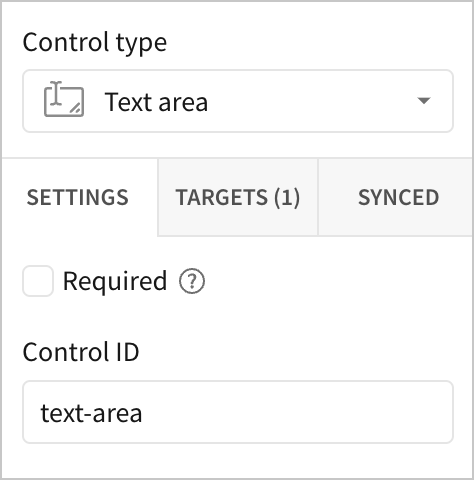Reference control values as parameters
You can reference the inputted or selected value in a control element in a formula or a SQL statement.
For example:
- To evaluate whether any contract expiration dates are occurring in within a month of a configurable date, create a date control, then reference the value of the date control in a formula.
- To dynamically adjust the weights of a linear regression calculation by creating a number input control for each configurable weight, then referencing the control values in the formula to calculate the linear regression.
- To reference the selected value in a control in the title of a chart, use dynamic text in the chart to add a formula that references the selected control value.
- Filter the results of a SQL query.
You can reference control values as parameters in workbooks or data models. Datasets use a different type of parameter, but you can also pass the value from a control to a dataset parameter. See Create and manage dataset parameters.
To reference a control value:
- Identify the control ID for a control.
- Determine the data type outputted by the control. See Types of controls in Intro to control elements.
- Reference the control value:
- In a formula, such as a calculated column or dynamic text. See Reference a control value in a formula.
- In a SQL statement. See Reference workbook control values in SQL statements.
Requirements
- You must have Can Edit access to the workbook.
- You must be assigned an account type with the Create, edit, and publish workbooks permission enabled.
Identify the control ID for a control
To reference a control value as a parameter, use the control ID. To locate the control ID:
-
Select a control.
-
In the element properties, in the Settings tab, locate the Control ID. In the following screenshot, the control ID is
text-area:
To reference a control ID as a parameter, enclose the ID in square brackets:
[New-Control-1]
The formula bar also displays control IDs as autocomplete suggestions.
You can update the control ID to a different value, but changing the ID can break existing parameters that reference the control.
If you change a control ID, update any references to the control ID in formulas or custom SQL. Elements that reference the control are listed in the Targets tab in the Currently referenced by: section.
For more details about control IDs, see About control IDs.
Reference a control value in a formula
The syntax that you use to reference a control value in a formula is different for different control types, due to the type of output for the control value:
- Single value (Most control types)
- Min/max values (Number range or range slider)
- Start/end values (Date range control)
- Multiple values (Multi-select list control)
Reference a single value control value in a formula
For controls that return a single value at a time, you can reference the control value as a parameter in a formula or custom SQL.
Supported control types:
- Single select list values
- Text input
- Text area
- Number input
- Date
- Segmented
- Drilldown
- Slider
- Checkbox
- Switch
- Top N
Syntax:
To reference the control value in a formula, enclose the control ID in square brackets and use the following syntax:
[New-Control-ID]
When referencing the control value as a parameter, make sure that the data type expected by the formula or the custom SQL statement exactly matches the data type of the control value. For example, a number input control can only have values of a Number data type, so cannot be used with Text functions unless first transformed in the formula.
Reference a number range or range slider control value in a formula
A number range or range slider control contain a minimum and a maximum value. When referencing the control as a parameter, specify which value to retrieve.
Supported control types:
- Number range
- Range slider
Syntax:
To retrieve the minimum value, use the following syntax:
[Range-Control-ID].min
To retrieve the maximum value, use the following syntax:
[Range-Control-ID].max
Reference a date range control value in a formula
A date range control contains a start value and an end value. When referencing the control as a parameter, specify which value to retrieve.
Supported control types:
- Date range
Syntax:
To retrieve the start value, use the following syntax:
[Date-Range-Control-ID].start
To retrieve the end value, use the following syntax:
[Date-Range-Control-ID].end
When you use a date range control as a parameter in a formula, the data type and the format of the date column must match. You cannot reference a date range start value in a formula if the date formats do not match.
For example, if a date range control Date-Range-Control-One outputs values in the format 2024-09-03 00:00:00 and another column Contract Expiry Date contains dates in the structure 2024-09-03, you might write a formula in a calculated column, Contract Status to evaluate the control value with the column value:
If([Date-Range-Control-One].end = [Contract Expiry Date], "Renew", [Date-Range-Control-One].end > [Contract Expiry Date], "Past Due", [Date-Range-Control-One].end < [Contract Expiry Date], "Valid")However, because the column date values do not match, the formula is invalid.
Reference a multi-select control value in a formula
A list control that allows multi selection returns values as an array. As a result, treat the parameter that retrieves those control values as an array data type.
Supported control types:
- List values
- Legend
Syntax:
For example, to evaluate if the selected options contain a specific option, use the ArrayContains function:
ArrayContains([Weekday-List-Multi-ID], "monday")
See Array functions.
Updated 6 days ago
